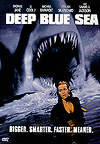Deep Blue Sea
Warner Home Video
Cast: Samuel L. Jackson, Saffron Burrows, Thomas Jane, Stellan Skarsgard
Extras: Commentary Track, Documentary, Deleted Scenes, Still Gallery, Theatrical Trailer
Rating:
"Deep Blue Sea" avoids the "open sea" angle that "Jaws" took and opts for a "Spam in a house" plot. "Deep Blue Sea" takes place in Aquatica, a research lab that is set in the middle of the ocean. Aquatica is owned by a pharmaceutical company which is controlled by Russell Franklin (Samuel L. Jackson). After a mishap at Aquatica, Franklin threatens to shut down the project. Dr. Susan McAlester (Saffron Burrows), the research project leader, convinces Franklin that her team is close to a breakthrough and invites Franklin to visit Aquatica and see for himself.
During the experiment to see if McAlester’s research is going to pay off, there is a tragic accident and Aquatica begins to take on water. As it turns out, the makos are not only big, but they are smart. The three killer sharks take advantage of this predicament and enter the research facility to hunt the humans. It’s a race against the clock as the panicked crew must find a way to make it to the surface while avoiding the man-eating monsters.
I’ve now seen "Deep Blue Sea" three times (once in the theater, and twice for this review). I don’t know how the film does it, but it works. It shouldn’t work, but it works, despite the problems. The plot is very tired and hackneyed. While it does an excellent job of staying away from the "Jaws" pitfalls (if you will), it resembles many other films, such as "Alien" and "Deep Rising." Once the basic premise is set up, we know that the characters will try different things to get to their destination and that along the way some of them will die. Also, we’ve got our stereotyped group of characters — the tough guy, the bad scientist, the smart-mouth, the weeper. Also, there are plot-holes a-plenty in the film and there are several key things that are never explained.
Part of the problem here lies with the CGI special effects. At times, they are awful. There are several shots where the sharks look like the two sharks from the Cinnaburst commercial. I kept waiting for them to high-five. Three kinds of sharks are featured in the film; live sharks, mechanical sharks, and CGI sharks. The mechanical sharks look great, are very convincing, and are fairly menacing. It’s the CGI sharks that shatter the illusion. On the supplemental material, director Renny Harlin challenges us to distinguish the real sharks from the computer generated sharks. It’s no challenge. When compared to films such as "Mighty Joe Young" or "Starship Troopers", the CGI here seems second-rate.
The other pivotal point to the film’s triumph is its no-holds-barred script. While the basic plot may not be very original, the way it is executed is. "Deep Blue Sea" has a definite edge to it and it can be downright mean-spirited at times. (The scene which leads to the facitily flooding still disturbs me.) Also, the game of cat-and-mouse between the sharks and humans becomes completely unpredictable. We’ve seen other films like this where the people are killled one at a time, but in "Deep Blue Sea", anything goes. It’s nearly impossible to predict who is going to die and when. In "Alien" we always had a feeling when someone was putting themselves in mortal danger (although it’s still shocking that Dallas is killed), but in "Deep Blue Sea", the shark attacks come swiftly and without warning, leaving the viewer shaken and not knowing what to trust. I’m surprised by how many other reviews or write-ups on "Deep Blue Sea" have given away the biggest shock in the film, so I’m being very careful to not reveal any of the film’s secrets.
When I saw the film in the theater, one thing that really stood out was the great use of stereo sound. I had hoped that the DVD would re-create this effect and it doesn’t disappoint. The <$DD,Dolby Digital> 5.1 soundtrack is very effective, offering a great deal of surround sound. The mix offers sound effects in two front channels, as well as the rear channels to maximize the feeling of claustrophobia and unease in the film. The sound is well-balanced, with the sudden loud sounds not being overpowering and the dialogue is always comprehensible, although substantially lower in volume than the effects – a tendency in many new movies.
There are two short documentaries which show behind the scenes footage. Warning; Do not watch these first, as they give away most of the plot. "When Sharks Attack" is fifteen minutes long and originally aired on HBO. This feature shows Harlin and actor Thomas Jane diving with live sharks to get some necessary footage for the film. It also offers several interviews with the cast.
There are five deleted scenes, which aren’t very impressive. They are presented at 2.35:1, but look like a video copy that has been transferred into MPEG. These scenes can be watched with or without commentary from Harlin, who does a good job of explaining why the scenes were excised. It’s obvious why these scenes were left out of the finished film. (I’d hoped to see some deleted scenes that helped to flesh out some of the plot holes.) The theatrical trailer is presented at 2.35:1 and is very effective. The DVD also contains a still gallery and talent files. I was very surprised that the music video for LL Cool J’s "Deepest Blue" didn’t make it onto the DVD.







